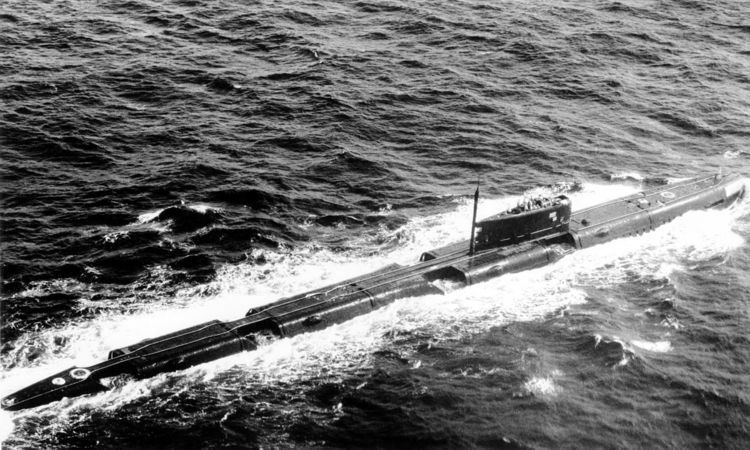Preceded by Whiskey Long Bin | ||
 | ||
In commission 19 November 1960–15 July 1994 Completed Echo I 5Echo II 29 | ||
The Echo class were nuclear cruise missile submarines of the Soviet Navy built during the 1960s. Their Soviet designation was Project 659 for the first five vessels, and Project 675 for the following twenty-nine. Their NATO reporting names were Echo I and Echo II. All were decommissioned by 1994.
Contents
Echo I class
The Soviet Echo I class (Project 659 class) were completed at Komsomolsk in the Soviet far east in 1960 to 1963. The Echo I class were classed as SSGNs armed with six launchers for the P-5 Pyatyorka (SS-N-3C, "Shaddock") land-attack cruise missile. The Echo I class had to operate in a strategic rather than anti-shipping role because of the lack of fire control and guidance radars.
As the Soviet SSBN force built up, the need for these boats diminished so they were converted to the Project 659T SSN's between 1969 and 1974. The conversion involved the removal of the cruise missiles, the plating over and the streamlining of the hull to reduce underwater noise of the launchers and the modification of the sonar systems to the standard of the November-class SSNs.
All the Echo Is were deployed in the Pacific Fleet although K-122 was damaged by a fire in compartment VII during a patrol mission near Okinawa in August 1980 and had to be towed back to Vladivostok for emergency dry docking (the submarine was removed from active service in October 1985). The last two boats were scrapped in the early 1990s.
Echo II class
The Echo II class (Project 675 class) were built at Severodvinsk (18 vessels) and Komsomolsk (11 vessels) between 1962 and 1967 as anti-carrier missile submarines. The Echo II class carried eight P-6 (SS-N-3a "Shaddock") anti-ship cruise missiles mounted in pairs above the pressure hull.
To fire the missiles, the ship had to surface and the missile was elevated to 15 degrees. The Echo II class also had fire control and guidance radar. The Echo II class could fire all eight missiles in 30 minutes, but would have to wait on the surface until the missile mid-course correction and final target selection had been sent unless guidance had been handed over to a third party.
From the mid-1970s, fourteen of the 29 Echo II class were converted during overhauls to carry the P-500 Bazalt (SS-N-12 "Sandbox") anti-ship cruise missile, with a range of 550 kilometres (340 mi). The conversions (Project 675M) could be distinguished by the fitting bulges either side of the sail.
Three of these modified units were further upgraded under Project 675MKV towards the end of the Cold War. The P-1000 Vulkan (GRAU 3M70) flies faster (Mach 2.3-2.5) than the P-500 and its range was extended to 700 kilometres (430 mi). It replaces steel components with titanium to reduce weight, and has an improved propulsion system. It appears to have used a similar fire-control system to the P-500, the Argon-KV and Argument radar. P-1000 was installed on three units of the Northern Fleet between 1987 and 1993; the conversion of two boats of the Pacific Fleet, the K-10 and K-34, was abandoned due to lack of funds.
The Echo II class were divided evenly between the Pacific and Northern Fleets. The boats were obsolete by the mid-1980s, and were deleted in 1989 and 1995.
Accidents
Submarines of the Echo class were involved in several accidents :
